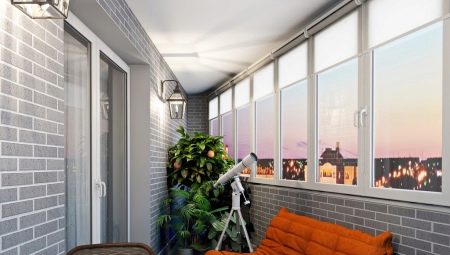Walls on a balcony made of bricks are most easily decorated with paint. This design method is not expensive and does not require special skills. You can create beautiful patterns and pictures using stencils. Painted walls look good in all modern interior styles.

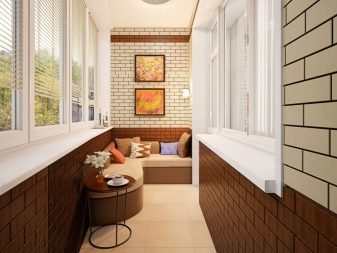
Design options
The brick wall on the balcony allows you to implement quite interesting design ideas. The interior always looks stylish and modern. Color schemes can be very different.
- Solid color. The entire wall is painted the same way, often in white. The surface itself becomes like a backdrop for balcony furniture and wall decor.
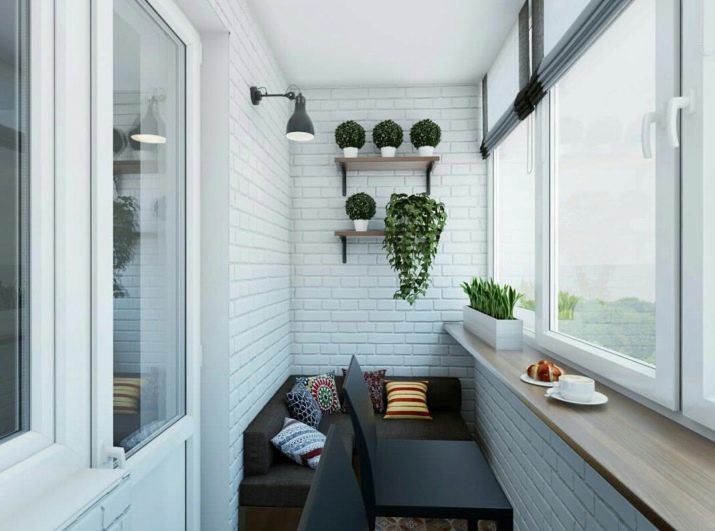
- Contrast. Requires more time and accuracy. In this case, the bricks are painted with one color, and the seams in another color. Other shades need to be selected so that they clearly contrast with each other.
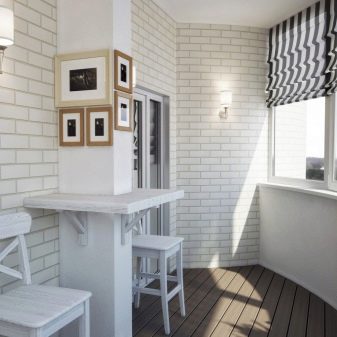

- Alternation. It is necessary to choose several shades according to the principle of combination or contrasting. Bricks of red, yellow and orange colors look juicy. Bricks are painted in a chaotic manner.
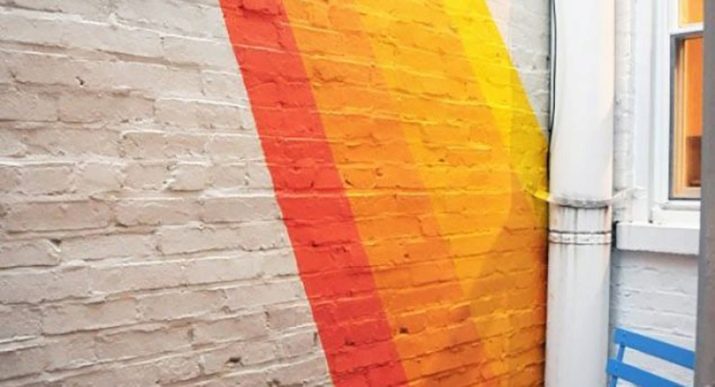
- Drawings. The entire wall is painted in one background color. Using stencils or figured rollers, a drawing is applied. You can make both patterns and whole pictures. If you have drawing skills, then you can simply display the drawing with brushes.
A popular design with a landscape or urban motif.

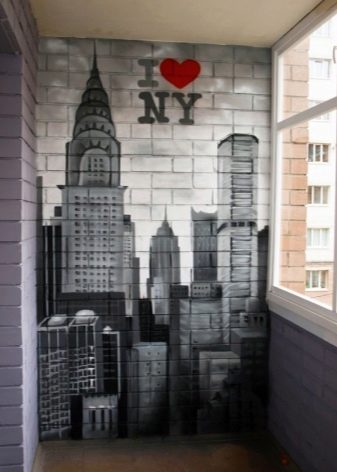
- Multi-colored. The technique is also known as one brick. A laborious, but very effective design option. Each brick needs to be painted in different colors. The final step is to process the seams with a thin brush.
It is recommended to use gray or black shades to emphasize each rectangle.
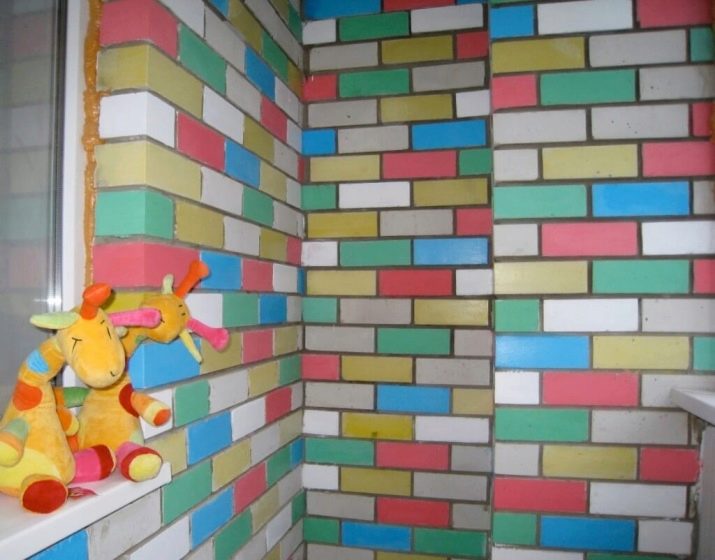
- Lettering. The wall is painted in one tone. After drying, take a marker and put the inscription in the right place. Typically, text is displayed in black or white, but any can be selected. It all depends on the interior and background color.

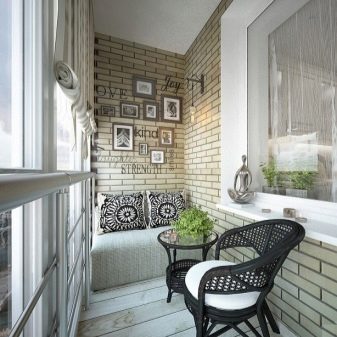
Paint selection
The balcony is part of the room, however, the conditions in it can be variable if there is no heating and glazing. Paints are divided into two large groups according to their purpose and can be used for internal or external works. The latter are actually universal and can be used even indoors. The use of paint for interior decoration on the street is unacceptable. Important material characteristics must be considered.
- Water resistance. Very useful property for finishing the balcony. The finish will not be affected by water or high moisture. On a heated balcony, such walls are easy to wash if necessary.
- Vapor permeability. A brick wall allows condensation to pass through, so the paint should have this property. If you do not take this feature into account, then the finish coating will soon begin to recede.
- Elasticity. Material with such a characteristic is smoother and easier to lay on the wall and does not suffer with mild deformation of the brickwork. The latter on the balcony may be associated with a temperature difference.
- UV resistant. This is a protection from the sun, which ensures that the paint does not fade and will delight you with its color for a long time.
- Hiding power. Microporous brick absorbs paint, as if impregnated. High-quality material with good density will allow you to design a wall in just 1-2 layers.
- Frost resistance. An important criterion when painting an unheated balcony or outdoor masonry. Special components in the composition provide resistance to low temperatures.
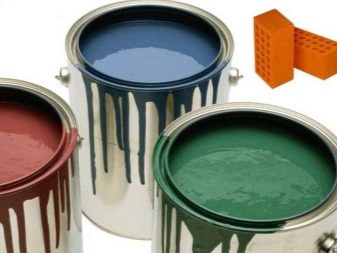
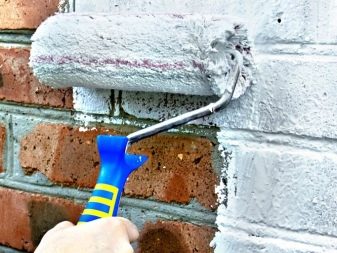
Experts recommend buying paints from well-known manufacturers. So, the paint will definitely be made to standards and will not release toxic substances into the air during operation. Among the important selection criteria, it is worth noting the basis of the paint.
Consider the most popular options for decorating a balcony.
- Latex paint. Safe to use indoors and have high decorative properties. It is noteworthy that the paint does not interfere with air circulation. Of the shortcomings, it is worth noting the low wear resistance. Despite this, removing the decorative trim from the wall is quite problematic.
- Organosilicon compounds. The coating is not afraid of mechanical stress and temperature surges. Great for bricks because it allows air to pass through. It is worth noting that such a paint and varnish material is quite expensive.
- Lime paints. The mineral composition contains calcium chloride and aluminum alum. Such cladding will have to be regularly updated, it quickly loses its properties. That is why the material is the most affordable.
- Oil paint. It is better to use light shades. Such a composition is unstable to the sun and will gradually fade. Light shades will remain attractive anyway. You can experiment if the balcony is not on the sunny side.

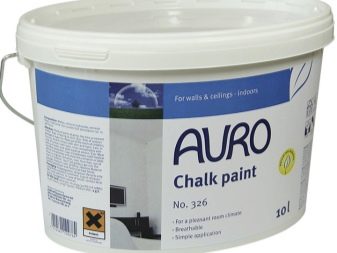
Surface preparation
A brick wall is initially unsuitable for painting. It is necessary to carry out preparatory work on the balcony so that the paint holds well.
- Remove the old decorative coating from the walls. Everything that does not hold well should be removed. It is especially important to get rid of pieces of flimsy brick.
- If necessary, treat the masonry with anti-fungal and mold products.
- It is very important to carefully remove all dust and dirt from the walls. It is convenient to use a vacuum cleaner indoors, it is better if with the air blow mode. When processing external walls, only a compressor is suitable.
- Brickwork on the balcony must be primed with a composition that is resistant to moisture.Additional waterproofing will increase the service life of the decorative coating. The primer is applied in 2-3 layers, each must dry completely. Manufacturers indicate detailed time information in the instructions or on the packaging.
- With the help of repair compounds, it is necessary to repair the seams and possible defects on the wall of the loggia.
- The treatment sites are primed again.
- It's time to plaster the walls. The composition will allow you to align defects and get perfect bricks. Plaster should be chosen universal, which is not afraid of moisture. You can apply the stand up to 3 cm, but less is better than more.
- The final step in the preparation will be putty. Apply the coating according to the manufacturer's instructions.
After drying the putty, you can proceed to the decorative finish of the brick. Tools are selected depending on the technique in which staining will be performed.
Beginners are advised to work with brushes or a roller. Depending on the type of paint, the coating in the future will need to be updated every 3-5 years.
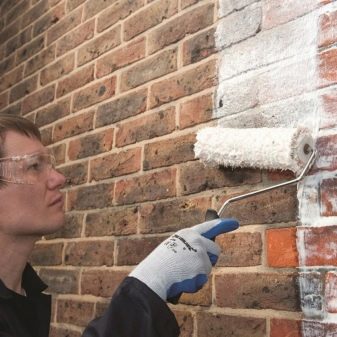
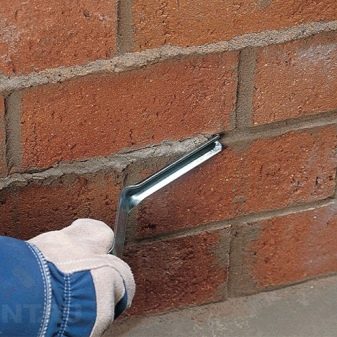
Painting Rules
If you choose the right paint, then decorating the walls will not be a big deal. It is important to accurately and objectively assess the climate on the balcony. After choosing a paint, it's time to take care of the tools. To paint a large space, it is more convenient to use a roller or spray.
Decorative staining in different colors requires brushes of the appropriate size. One will allow to process bricks, and the second - the seams between them. A separate brush will be needed if necessary to create drawings.
Masking tape will make the walls more neat and do not stain the ceiling, floor. It is especially important to take this point into account when using a spray gun or if you need to create a clear border between the colors. A special container (bath) for paint will make the process of working with a roller or brush more comfortable. It will be easier to apply paint in a thin layer.

Experts believe that painting masonry is the easiest way to decorate. Their valuable advice will make the wall beautiful and durable.
- Paint with a roller or brush should be strictly in one direction. Work correctly from floor to ceiling.
- To achieve the most vivid and saturated tone, it is recommended to apply two thin layers of paint. At the same time, it is strictly forbidden to do one, but thick. The material will dry out poorly and may begin to exfoliate in different places.
- The first coat of paint should dry completely before applying the second.
- If the balcony is not glazed, then it is worthwhile to work only in calm weather. Otherwise, fresh paint will immediately attract dust and small debris.
- When using a spray gun, it is worth adjusting the ink supply so as not to create smudges and splashes. The layer should be as even as possible. Such staining is not recommended for beginners.
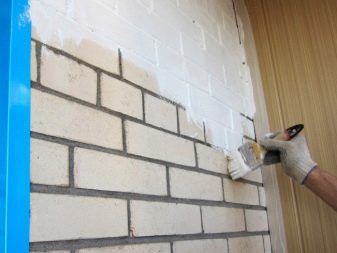
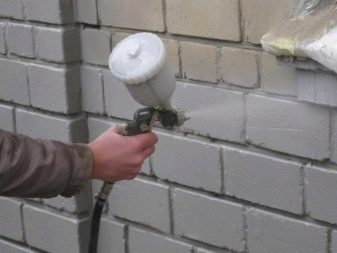
Decorating the walls on the balcony with paint will be quite simple if you follow all the recommendations and instructions of the manufacturer. Neglecting advice for the sake of a quick completion of the repair is not worth it, this will seriously affect the quality.
Proper preparation of the walls and accurate application of paint will give an excellent result.
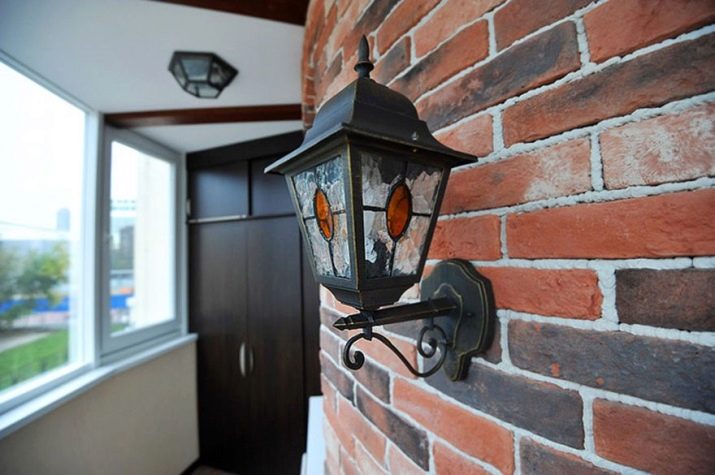
Good examples
Brick painting allows you to create a unique interior on the balcony. Everything directly depends on skills and preferences. We offer interesting examples of cladding.
- The bricks are painted in calm beige shades, and the seams are highlighted in dark gray. Wall decor is in good harmony with the overall interior.
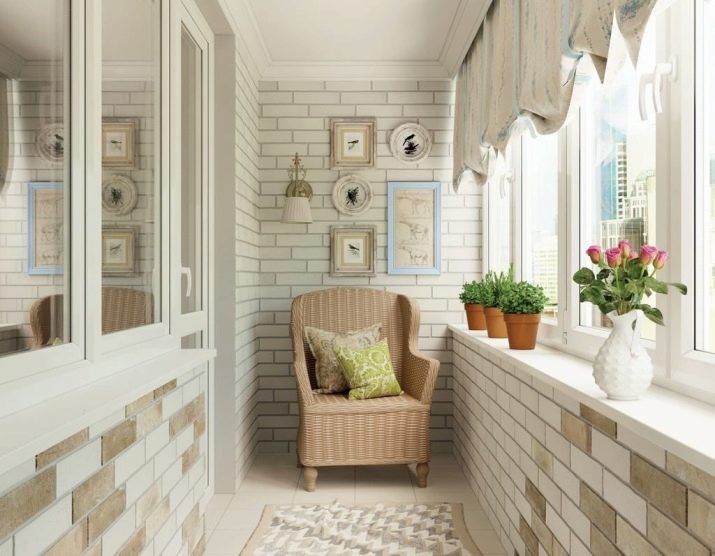
- A lot of work has been done to create a whitewashed brick effect. The general atmosphere is very comfortable.
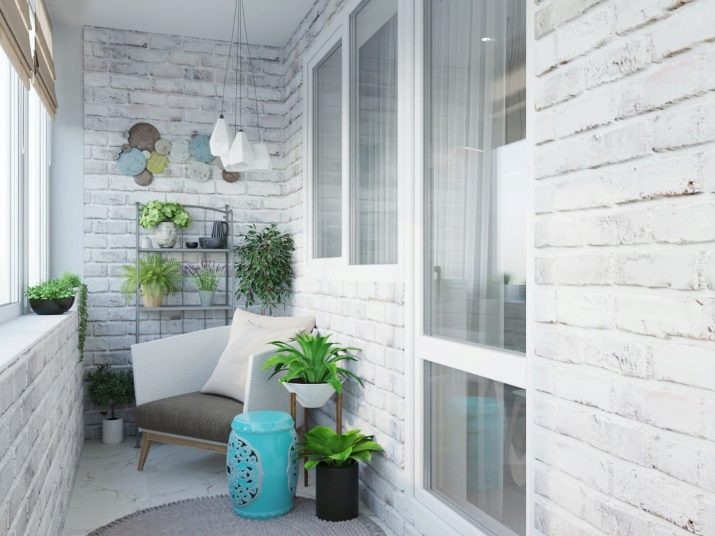
- A red brick with white seams looks great. The narrow balcony visually seems bigger.
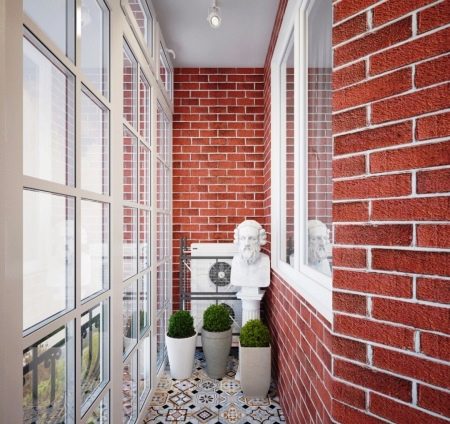
- The combination of bricks with a decorative wall looks good thanks to harmonious shades. The color of the walls and floor are selected according to the principle of similarity.
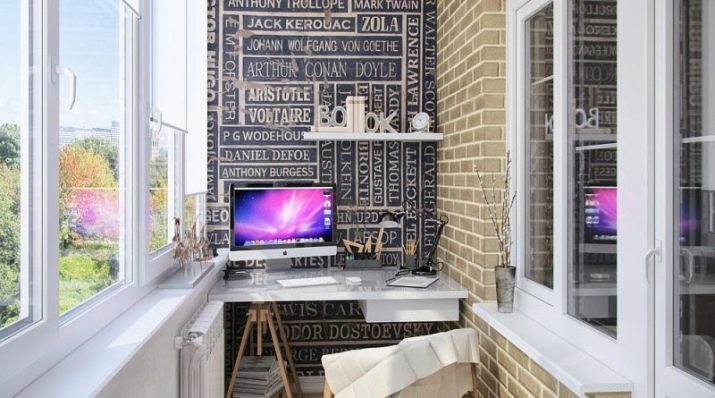
- The brick looks like it wasn’t processed at all. The general look is interesting and stylish.

See how to paint a brick wall on a balcony in the next video.
